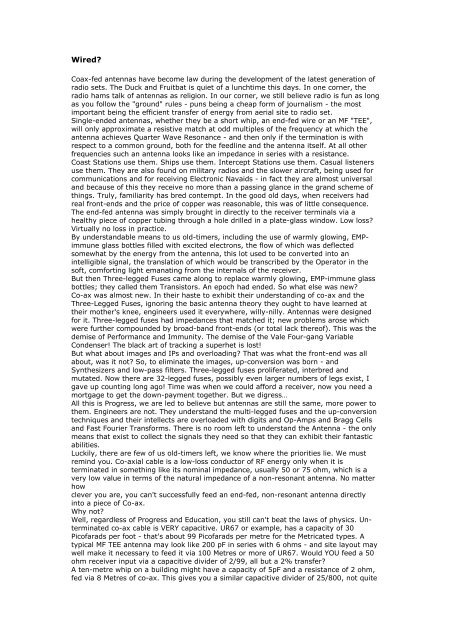Listener's Guide - 1999 - The Listeners Guide
Listener's Guide - 1999 - The Listeners Guide
Listener's Guide - 1999 - The Listeners Guide
Create successful ePaper yourself
Turn your PDF publications into a flip-book with our unique Google optimized e-Paper software.
Wired?Coax-fed antennas have become law during the development of the latest generation ofradio sets. <strong>The</strong> Duck and Fruitbat is quiet of a lunchtime this days. In one corner, theradio hams talk of antennas as religion. In our corner, we still believe radio is fun as longas you follow the "ground" rules - puns being a cheap form of journalism - the mostimportant being the efficient transfer of energy from aerial site to radio set.Single-ended antennas, whether they be a short whip, an end-fed wire or an MF "TEE",will only approximate a resistive match at odd multiples of the frequency at which theantenna achieves Quarter Wave Resonance - and then only if the termination is withrespect to a common ground, both for the feedline and the antenna itself. At all otherfrequencies such an antenna looks like an impedance in series with a resistance.Coast Stations use them. Ships use them. Intercept Stations use them. Casual listenersuse them. <strong>The</strong>y are also found on military radios and the slower aircraft, being used forcommunications and for receiving Electronic Navaids - in fact they are almost universaland because of this they receive no more than a passing glance in the grand scheme ofthings. Truly, familiarity has bred contempt. In the good old days, when receivers hadreal front-ends and the price of copper was reasonable, this was of little consequence.<strong>The</strong> end-fed antenna was simply brought in directly to the receiver terminals via ahealthy piece of copper tubing through a hole drilled in a plate-glass window. Low loss?Virtually no loss in practice.By understandable means to us old-timers, including the use of warmly glowing, EMPimmuneglass bottles filled with excited electrons, the flow of which was deflectedsomewhat by the energy from the antenna, this lot used to be converted into anintelligible signal, the translation of which would be transcribed by the Operator in thesoft, comforting light emanating from the internals of the receiver.But then Three-legged Fuses came along to replace warmly glowing, EMP-immune glassbottles; they called them Transistors. An epoch had ended. So what else was new?Co-ax was almost new. In their haste to exhibit their understanding of co-ax and theThree-Legged Fuses, ignoring the basic antenna theory they ought to have learned attheir mother's knee, engineers used it everywhere, willy-nilly. Antennas were designedfor it. Three-legged fuses had impedances that matched it; new problems arose whichwere further compounded by broad-band front-ends (or total lack thereof). This was thedemise of Performance and Immunity. <strong>The</strong> demise of the Vale Four-gang VariableCondenser! <strong>The</strong> black art of tracking a superhet is lost!But what about images and IPs and overloading? That was what the front-end was allabout, was it not? So, to eliminate the images, up-conversion was born - andSynthesizers and low-pass filters. Three-legged fuses proliferated, interbred andmutated. Now there are 32-legged fuses, possibly even larger numbers of legs exist, Igave up counting long ago! Time was when we could afford a receiver, now you need amortgage to get the down-payment together. But we digress…All this is Progress, we are led to believe but antennas are still the same, more power tothem. Engineers are not. <strong>The</strong>y understand the multi-legged fuses and the up-conversiontechniques and their intellects are overloaded with digits and Op-Amps and Bragg Cellsand Fast Fourier Transforms. <strong>The</strong>re is no room left to understand the Antenna - the onlymeans that exist to collect the signals they need so that they can exhibit their fantasticabilities.Luckily, there are few of us old-timers left, we know where the priorities lie. We mustremind you. Co-axial cable is a low-loss conductor of RF energy only when it isterminated in something like its nominal impedance, usually 50 or 75 ohm, which is avery low value in terms of the natural impedance of a non-resonant antenna. No matterhowclever you are, you can't successfully feed an end-fed, non-resonant antenna directlyinto a piece of Co-ax.Why not?Well, regardless of Progress and Education, you still can't beat the laws of physics. Unterminatedco-ax cable is VERY capacitive. UR67 or example, has a capacity of 30Picofarads per foot - that's about 99 Picofarads per metre for the Metricated types. Atypical MF TEE antenna may look like 200 pF in series with 6 ohms - and site layout maywell make it necessary to feed it via 100 Metres or more of UR67. Would YOU feed a 50ohm receiver input via a capacitive divider of 2/99, all but a 2% transfer?A ten-metre whip on a building might have a capacity of 5pF and a resistance of 2 ohm,fed via 8 Metres of co-ax. This gives you a similar capacitive divider of 25/800, not quite

















